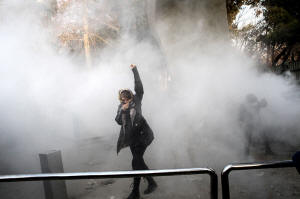Truckers' protests in Iran grow and win support from prominent
dissidents
[May 29, 2025] By
MELANIE LIDMAN
DUBAI, United Arab Emirates (AP) ó Truck drivers in Iran blocked roads
and ports Wednesday as part of their strike protesting low salaries,
high insurance rates, and a possible hike in fuel prices.
The strikes, which began last Thursday in the southern port city of
Bandar Abbas, one of the countryís main transportation and shipping
hubs, have now spread across Iran. The protests are slowly gaining
steam, supported by prominent dissident voices, and could morph into
more serious protests against the government.
Last week, the Iranian government announced plans to increase the price
of fuel for trucks from 4 cents per liter (15.14 cents per gallon) to
nearly 50 cents per liter (about $1.90 per gallon) in late June. With
massive resources of oil and gas, Iran has some of the lowest fuel
prices in the world. The average price for a gallon of gas in the United
States on Wednesday was $3.16, according to AAA, a drivers' assistance
and advisory service.
Dissident Iranians expressed their support for the truckers. Film
director Jafar Panahi, who last week won the Palme díOr award at the
Cannes Film Festival, encouraged the truck drivers to start a nationwide
strike.
ďThe strike is a loud cry to the government: enough is enough! Stop the
massive suppression and plundering before everything is lost and nothing
remains for people,Ē he wrote on Instagram.

Nobel Peace Prize laureate Narges Mohammadi, who was imprisoned on
charges of collusion against state security and propaganda against
Iranís government, also expressed her support for the strike on X.
Videos circulating on social media showed lines of trucks parked on the
sides of major roads. Iran said the plan is intended to prevent fuel
smuggling into neighboring countries. Fuel in neighboring Pakistan costs
more than a dollar per liter ($4 per gallon).
Many of Iran's previous rounds of anti-government protests started out
as economic protests over local issues, including demonstrations in 2017
and 2018. Those protests were met with a heavy reaction by the police
and the Basij, the all-volunteer force of Iranís paramilitary
Revolutionary Guard.
[to top of second column] |

In this photo taken by a person not employed by the Associated Press
and obtained by the AP outside Iran, a university student attends a
protest inside Tehran University after a smoke grenade was thrown by
anti-riot Iranian police, in Tehran, Iran, Dec. 30, 2017. (AP Photo,
File)
 In 2019, anger over the government
eliminating the gasoline subsidy also sparked nation-wide protests.
More than 1,000 people were arrested and the country temporarily
shut down the internet. Protests also rocked the country in 2022
over the death of 22-year-old Mahsa Amini, who died in Iranian
security custody after morality police detained her for improperly
wearing her headscarf, or hijab.
On Saturday, Jalal Mousavi, an official in the truckersí union, said
truckers are striking because they are struggling with the rising
costs of fuel, spare parts and repairs.
The strike underscores the mounting economic pressures on Iran as it
struggles to secure relief from crippling sanctions in the ongoing
negotiations with the United States. Iranís oil sector, the
lifeblood of its economy, has been damaged by the impact of American
sanctions over Tehranís nuclear program, and it is one of the
central issues under discussion in the Iran-U.S. negotiations.
On Wednesday, Fatemeh Mohajerani, the spokesperson of the
governmentís Cabinet, said lawmakers had discussed the strike in the
Cabinet meeting and the administration will consider the truckers'
needs. State TV showed footage of routine activities in truck
terminals and ports.
___
Associated Press writer Nasser Karimi contributed to this report
from Tehran.
All contents © copyright 2025 Associated Press. All rights reserved
 |